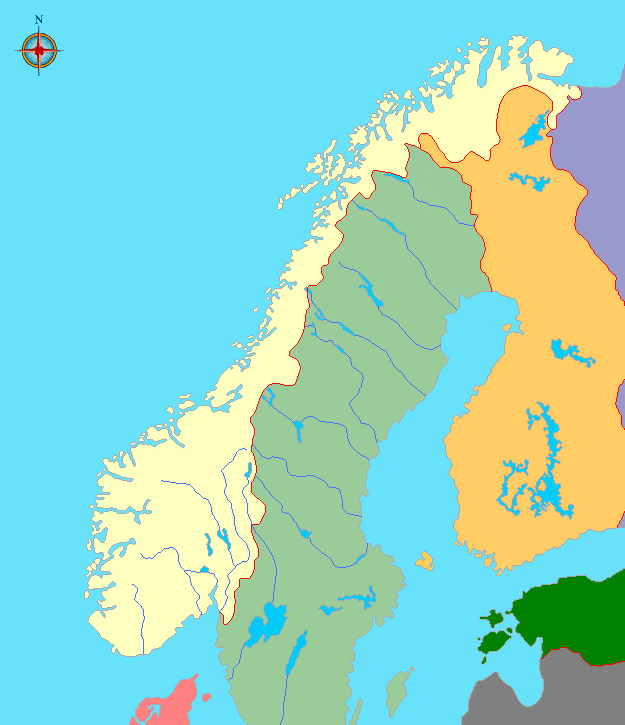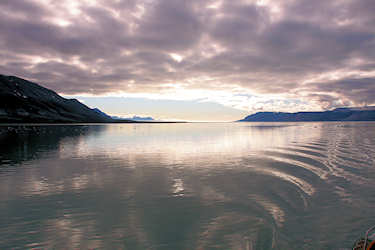Norway

Historie
The earliest traces of human occupation in Norway are found along the coast, where the huge ice shelf of the
Last Ice Age first melted between 11.000 and 8.000 BC. The oldest finds are stone tools dating from 9.500
to 6.000 BC, discovered in Finnmark (Komsa culture) in the north and Rogaland (Fosna culture) in the southwest.
Between 3000 and 2500 BC, new settlers (Corded Ware culture) arrived in eastern Norway. They were Indo-European
farmers who grew grain and kept livestock, and gradually replaced the hunting-fishing population of the west coast.
From about 1500 BC, bronze was gradually introduced. Burial cairns built close to the sea as far north as Harstad and
also inland in the south are characteristic of this period, with rock carving motifs that differ from those of the
Stone Age, depicting ships resembling the Hjortspring boat, while large stone burial monuments known as
stone ships were also erected.
About 1000 BC, speakers of Uralic languages arrived in the north and assimilated with the indigenous population,
becoming the Sami people.
The last century BC saw a widespread cultural development. The Norse adapted letters and created their own alphabet,
runes. Trading with Romans also took place, largely furs and skins in exchange for luxury goods. Some of the
most powerful farmers became chieftains. The chieftains' power increased during the Migration Period between
400 and 550 AD as other Germanic tribes migrated northwards and local farmers wanted protection. This also resulted
in the construction of simple fortifications.
The mid-9th century saw the largest chieftains of the petty kingdoms engaged in major power struggle. Harald
Fairhair began the process of unifying Norway when he entered an alliance with the Earls of Lade and was
able to unify the country after the decisive Battle of Hafrsfjord (872).
The Viking Age (800-1050 AD) was a period of Scandinavian expansion through trade, colonization and raids.
The first raid was against Lindisfarne (England) in 793 and is considered the beginning of the Viking Age. This could
take place because of the development of the longship, suitable for travel across the sea, and advanced navigation
techniques. Vikings were well-equipped, had chain mail armor, were well-trained and had a psychological advantage over
Christian counterparts since they believed that being killed in combat would result in them going to Valhalla. In
addition to gold and silver, an important outcome from the raids were thralls ("unfree servant"), which were
brought to the Norwegian farms as slave workforce. While the men were out at sea, the management of the farm was under
control of the women.
In 1130, a civil war era broke out over succession to the throne, which allowed all the king's sons to rule
jointly by dividing Norway into portions for each to rule. At times there were periods of peace, before a lesser son
allied himself with a chieftain and started a new conflict. The Archdiocese of Nidaros was created in 1152 in
an attempt to control the appointment of kings. The church inevitably took sides in these conflicts, with the church's
influence on the king also becoming an issue in the civil wars. The wars ended in 1217 with the appointment of
Håkon Håkonsson, who introduced clear succession laws.
The 13th century is described as Norway's Golden Age, with peace and increase in trade, especially with the
British Islands, although Germany became increasingly important towards the end of the century. Throughout the High
Middle Ages the king established Norway as a state with a central administration with local representatives. In 1349
the Black Death spread to Norway and had within a year killed a third of the population. Many communities were entire
wiped out, resulting in an abundance of land, allowing farmers to switch to more animal husbandry. The reduction in
taxes weakened the king's position, and many aristocrats lost the basis for their surplus, reducing some to mere
farmers.
The Hanseatic League took control of Norwegian trade in the 14th century and established trading posts in most
Norwegian port cities, such as Oslo and Bergen, which had the largest German colony.
In 1380, Olaf Haakonsson inherited both the Norwegian and Danish thrones, creating a union between the two countries.
In 1397, under Margaret I, the Kalmar Union (1397-1536) was created between the three Scandinavian
countries. Margaret pursued a centralising policy which inevitably favoured Denmark, because it had a greater
population than Norway and Sweden combined. Margaret also granted trade privileges to the Hanseatic merchants of Lübeck
in Bergen in return for recognition of her right to rule, and these hurt the Norwegian economy. The Hanseatic merchants
formed a state within a state in Bergen for generations.
Sweden was able to pull out of the Kalmar Union in 1523, thus creating Denmark–Norway (1536-1814) under the rule
of a king in Copenhagen. Frederick I of Denmark favoured Martin Luther's Reformation, but it was not popular in Norway,
where the Church was the one national institution and the country was too poor for the clergy to be very corrupt.
Initially, Frederick agreed not to try to introduce Protestantism to Norway but in 1529 he changed his mind. All church
valuables were sent to Copenhagen and the forty percent of the land which was owned by the church came under the control
of the king. Danish was introduced as a written language, although Norwegian remained distinct dialects. Professional
administration was now needed and power shifted from the provincial nobility to the royal administration: district
stipendiary magistrates were appointed as judges and the sheriffs became employees of the crown rather than of the
local nobility. In 1572 a governor-general was appointed for Norway with a seat at Akershus Fortress in Oslo. From
the 1620s professional military officers were employed.
After Denmark–Norway was attacked by the United Kingdom at the Battle of Copenhagen (1807), it entered into an alliance
with Napoleon. As the Danish kingdom found itself on the losing side in 1814, it was forced, under terms of the
Treaty of Kiel, to cede Norway to the king of Sweden, while the old Norwegian provinces of Iceland, Greenland
and the Faroe Islands remained with the Danish crown. The Union between Sweden and Norway (1814-1905) was
born. Under this arrangement, Norway kept its liberal constitution and its own independent institutions, though it
shared a monarch and foreign policy with Sweden.
Christian Michelsen, a shipping magnate and statesman, Prime Minister of Norway from 1905 to 1907, played a
central role in the peaceful separation of Norway from Sweden on 7 June 1905. After a national referendum confirmed
the people's preference for a monarchy over a republic, the Norwegian government offered the throne of Norway to
Prince Carl of Denmark, and Parliament unanimously elected him king. He took the name of Haakon VII, after
the mediæval kings of independent Norway.
Norway adopted a policy of neutrality from 1905; during World War I the Norwegian merchant marine was largely used
in support of the British, resulting in Norway being classified as The Neutral Ally.
From the start of World War II in 1939, Norway maintained a strict neutrality. Both Britain and Germany realized the
strategic location; both made plans to invade Norway, regardless of Norwegian opposition. The Germans struck first and invaded
Norway on 9 April 1940. After furious battles with Norwegian and British forces, Germany prevailed and controlled the
country until the end of the war. The German goal was to use Norway to control access to the North Sea and the Atlantic,
and to station air and naval forces to stop convoys from Britain to the USSR.
The post-war years saw an increased interest in Scandinavism, resulting in Scandinavian Airlines System in 1946,
the Nordic Council in 1952 and the Nordic Passport Union along with the metric system being introduced.
By 1990, Norway was Europe's largest oil producer and by 1995 it was the world's second-largest oil exporter. Membership
in the European Union was rejected in a 1994 referendum, with Norway instead joining the European Economic Area
and later also the Schengen Area.
I did visited Norway in august 2013.
On that trip i visitted Svalbard
Please let me know when you're having questions.
i would be pleased to help you.
Things to do and other tips
